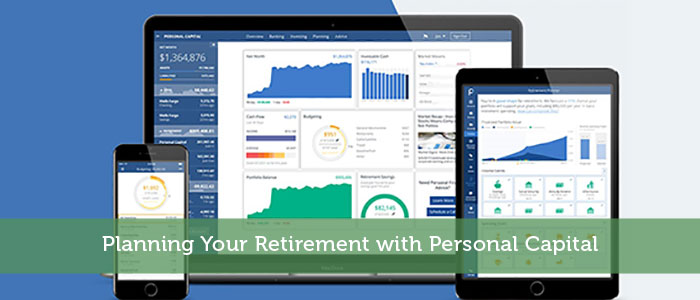Personal Capital is a great platform for managing your finances, but when you look beyond the surface it offers so much more. It gives you the ability to keep track of all your financial accounts, and this is particularly useful if your money is more spread out. But you shouldn’t overlook its ability to help you with your retirement savings.
Personal Capital has a built-in retirement planner that will help you develop a strategy to suit your spending and saving habits. This could be useful, especially if you don’t know where to start. And this service is included with all the other free features that this platform has to offer.
Click to Check out Personal Capital for Free.
How the Retirement Planner Works
The retirement planner will track your progress, which will help to keep you motivated as you save. Plus, it will take larger expenses into account, as well as any large sums of money you can put away at once. This can include:
- The sale of a business
- Profits made from the sale of stock
- Getting an inheritance
The retirement planner takes other factors into account as well. It will look at things like taxes and inflation – both of which could impact your ability to save.
At the same time, it will look at other behaviors that could increase your ability to save – things like:
- Savings increases
- Sales of certain securities (such as ETF’s and mutual funds)
The retirement planner will also look at whether or not your spouse has retired. I know this won’t be an issue for young folks, but it could be a factor for seniors who are still working.
What to Do with This Information
With all the data it has collected, it will give you some advice on how to proceed with your retirement savings plan. It uses a model that is often referred to the “Monte Carlo Simulation Method,” where it focuses on past trends to develop a future plan. This makes it hard to get an accurate prediction of future events. Besides, no one really knows what the future holds. Certain unexpected things – such as economic collapses and other financial disasters – could happen that could put your savings plan on hold.
There is another thing you have to consider. Small banks that are located in certain rural areas may not be recognized by Personal Capital’s retirement planner. If that’s the case, you may have to enter the data in manually. This can be an extremely time-consuming process, as you will have to go through all your financial records.
Types of Retirement Accounts
An Individual Retirement Account (IRA) is any non-qualified retirement account. In other words, an IRA doesn’t go through a company or any other organization by which a person could be employed.
There are two types of IRAs:
- Traditional IRAs
- Roth IRAs
While they are similar in many respects, the difference comes in the way they’re taxed. In a traditional IRA, any contributions and interest are on a “tax-deferred” basis. In other words, you don’t pay taxes on that money until it is withdrawn.
A Roth IRA, on the other hand, does not have the same tax benefits. While any interest grows tax-free, you will have to pay taxes on any contributions you make to the account. The plus side is that, because the taxes on that money have already been paid, you don’t have to pay them when it is withdrawn. This could be an advantage, since you will have some tax-free cash that you will have when you retire.
Conclusion
While Personal Capital’s retirement planner is not perfect, it can still be a great tool to help you get started. Combine that with the ability to see all your financial accounts in one place, and you will be able to make sure you don’t outlive your income.
Click to Check out Personal Capital for Free.






Might have to give this program a try … great review!